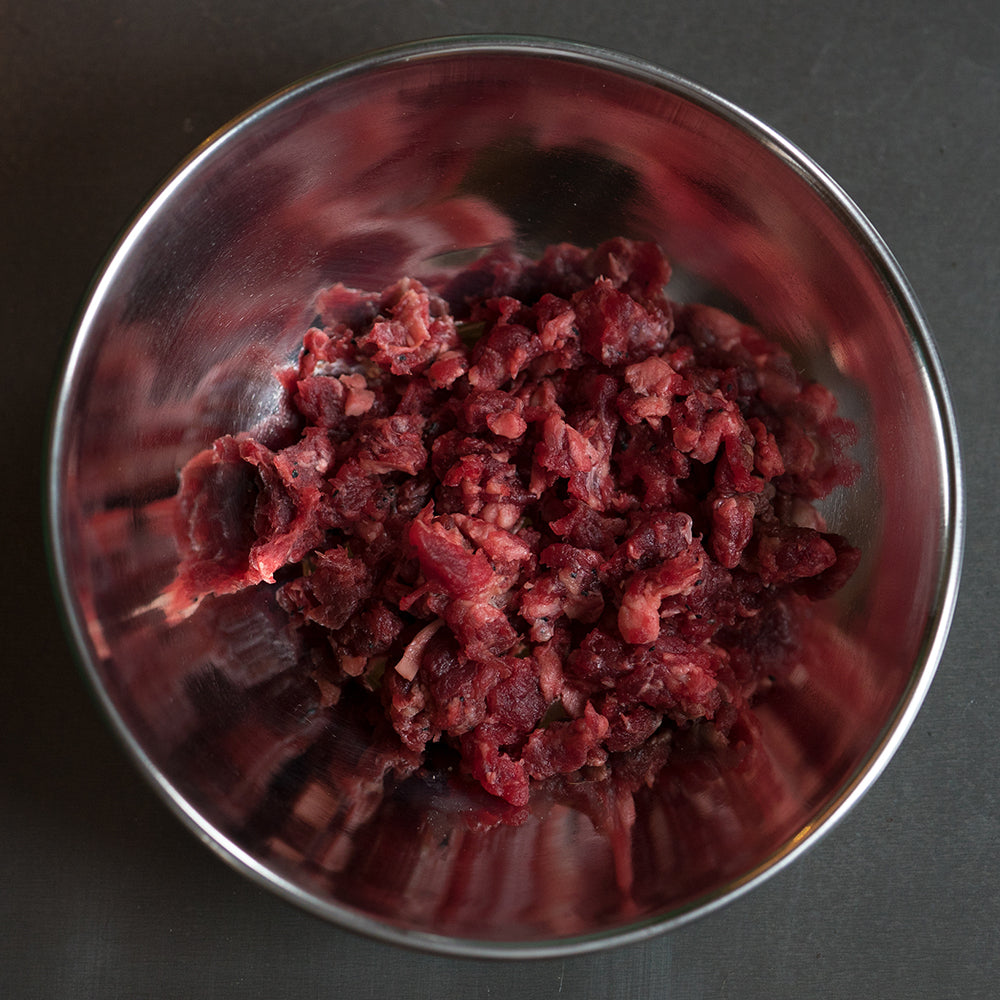
Dry Dog Food vs. Raw Dog Food
Share

Choosing the right food for your dog is essential to their health, behavior and longevity. There are a lot of options out there, but what it comes down to is dry or raw. There are pros and cons of both diets that should be considered when exploring new diets for your dog.
Dogs are carnivores.
Think about this. Dogs became domesticated thousands of years ago, yet processed, dry dog food has only been on the market for 100 years. So, what did dogs eat before then? Meat- in the shape of scraps, carcasses and what they killed on their own.
Even today, the most domesticated dogs still have ancestral history tracing back to wolves. Dogs have the same digestive systems as their ancestors, making them carnivores. When processed, commercial dog food first came on the market, people loved the convenience of being able to scoop kibble and pour it into a bowl. Their veterinarians said it was a healthy and balanced diet for their dogs. As this new pet food industry grew, so did health issues with dogs. Illnesses and diseases that affect dogs like periodontal disease, obesity, chronic digestive problems, cancer, inflammation, kidney disease, and allergies have been on the rise since the introduction of dry, processed dog food.
The products used to create dry kibble or processed dog food are essentially leftovers from the human food industry. With the growth of illnesses in dogs and dog food recalls, the safety of dry, processed dog food is being looked at. Just with any processed product, it is important to read the label and know exactly what is in the food you are feeding your pet.
The ingredients in dry, processed food can vary in form, quality, and nutrition.
The materials used in dry, processed dog foods are often purchased from open market sources. The products used in creating most dry, processed dog food come from unsanitary farms, different states, storage plants or countries- which can look very different than the beautiful fresh cuts of meats and veggies shown on the product’s packaging. Even the packaging can be misleading. For example, you might think chicken and poultry can be used interchangeably. But with pet food labels, if a product is labeled chicken, it has to contain that species but poultry, can be chicken, turkey, ducks, vultures, seagulls, etc.
This does not mean that all dry, processed dog foods are bad for your dog, but it is important to try to read the labels and know the sources of the products used in your dog’s food. Finding a dog food that is rich in nutrients, healthy, affordable and appealing to your dog can be overwhelming. That, combined with people becoming more aware of the dangers in some dry, processed food is why they are turning to other healthy alternatives like raw food and homemade diets.
Give your dog a healthy alternative.
A raw beef based diet for dogs provides the nutrition they need the way nature intended it. Food in the raw-state means the proteins, vitamins and mineral are more bio-available and easier for dogs to absorb. There are many health benefits to a raw-based diet including reduced allergies, healthier skin and coat, healthy weight, better stools, cleaner teeth and more energy. Read more about these benefits here: 5 Reasons Why a Raw Beef Based Diet is Best for Your Dog.
When you think about raw food, you might worry about contamination or salmonella. But because dogs’ bodies are built to catch, kill and consume prey in the wild, their bodies are also equipped to deal with different bacteria. They can handle different types of bacteria that humans can’t. Dog’s stomachs are very acidic with a pH range of 1-2.5. Not many things could withstand an acidic environment like that.
While protein from meat should make up the majority of a dog’s diet, dogs also get nutrients from grains and produce. These non-meat additions are a good source of essential vitamins and minerals. Most homemade meals are prepared using 65% protein, ideally lean, raw beef and 35% supplements and vitamins, like pasta, high-quality kibble, or veggies.
Know where your dog’s food is coming from.
The key to finding the right diet for your dog is knowing exactly what you are feeding your dog and making sure that it’s a healthy, balanced diet of protein and supplemental nutrients. This is much easier done when you have full control over their meals by preparing them yourself at home.




